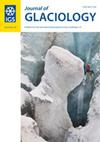Beyond the Stokes approximation: shallow visco-elastic ice-sheet models
IF 2.6
3区 地球科学
Q2 GEOGRAPHY, PHYSICAL
引用次数: 0
Abstract
Abstract The hypothesis that ice-sheet evolution is only controlled by the long-term non-Newtonian viscous behavior of ice has been challenged by observations indicating that effects like brittle failure, stick-slip sliding, tides and wave action may affect ice-sheet evolution on sub-daily timescales. Over these timescales, the quasi-static-creep approximation is no longer appropriate and elastic effects become important. Simulating elastic effects in ice-sheet models over relevant timescales, however, remains challenging. Here, we show that by including a visco-elastic rheology and reintroducing the oft neglected acceleration term back into the ice-sheet stress balance, we can create a visco-elastic system where the velocity is locally determined and information propagates at the elastic wave speed. Crucially, the elastic wave speed can be treated like an adjustable parameter and set to any value to reproduce a range of phenomena, provided the wave speed is large compared to the viscous velocity. We illustrate the system using three examples. The first two examples demonstrate that the system converges to the steady-state viscous and elastic limits. The third example examines ice-shelf rifting and iceberg calving. This final example hints at the utility of the visco-elastic formulation in treating both long-term evolution and short-term environmental effects.超越斯托克斯近似:浅粘弹性冰盖模型
冰盖演化仅受冰的长期非牛顿粘性行为控制的假设受到了挑战,观测结果表明,脆性破坏、粘滑滑动、潮汐和波浪作用等因素可能在亚日时间尺度上影响冰盖演化。在这些时间尺度上,准静态蠕变近似不再合适,弹性效应变得重要。然而,在相关时间尺度上模拟冰盖模型中的弹性效应仍然具有挑战性。在这里,我们表明,通过包括粘弹性流变并将经常被忽视的加速度项重新引入冰盖应力平衡,我们可以创建一个粘弹性系统,其中速度是局部确定的,信息以弹性波速传播。至关重要的是,弹性波速可以被视为一个可调参数,并且可以设置为任何值来重现一系列现象,只要波速比粘性速度大。我们用三个例子来说明这个系统。前两个算例表明,系统收敛于稳态粘弹性极限。第三个例子考察了冰架裂陷和冰山崩解。最后一个例子暗示了粘弹性公式在处理长期演变和短期环境影响方面的效用。
本文章由计算机程序翻译,如有差异,请以英文原文为准。
求助全文
约1分钟内获得全文
求助全文
来源期刊

Journal of Glaciology
地学-地球科学综合
CiteScore
5.80
自引率
14.70%
发文量
101
审稿时长
6 months
期刊介绍:
Journal of Glaciology publishes original scientific articles and letters in any aspect of glaciology- the study of ice. Studies of natural, artificial, and extraterrestrial ice and snow, as well as interactions between ice, snow and the atmospheric, oceanic and subglacial environment are all eligible. They may be based on field work, remote sensing, laboratory investigations, theoretical analysis or numerical modelling, or may report on newly developed glaciological instruments. Subjects covered recently in the Journal have included palaeoclimatology and the chemistry of the atmosphere as revealed in ice cores; theoretical and applied physics and chemistry of ice; the dynamics of glaciers and ice sheets, and changes in their extent and mass under climatic forcing; glacier energy balances at all scales; glacial landforms, and glaciers as geomorphic agents; snow science in all its aspects; ice as a host for surface and subglacial ecosystems; sea ice, icebergs and lake ice; and avalanche dynamics and other glacial hazards to human activity. Studies of permafrost and of ice in the Earth’s atmosphere are also within the domain of the Journal, as are interdisciplinary applications to engineering, biological, and social sciences, and studies in the history of glaciology.
 求助内容:
求助内容: 应助结果提醒方式:
应助结果提醒方式:


